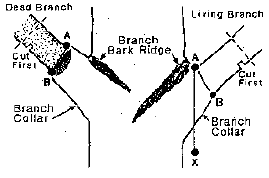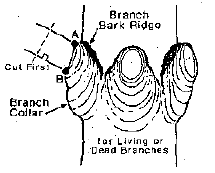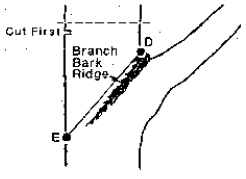Energy Conservation
Over the course of 50 years, a single tree can generate $31,250 of oxygen, provide $62,000 worth of air pollution control, recycle $37,500 worth of water, and control $31,500 worth of soil erosion. According to the U.S. Department of Agriculture, the net cooling effect of a young, healthy tree is equivalent to ten room-size air conditioners operating 20 hours a day. According to the USDA Forest Service, trees properly placed around buildings can reduce air conditioning needs by 30 percent and can save 20-50 percent in energy used for heating. And according to Dr. Lowell Ponte, shade from trees could save up to $175 per year (per structure) in air conditioning costs.
Water Quality Protection
Strategically placed trees around our lakes, rivers, and streams help filter sediments and contaminants that would otherwise enter the water supply. Trees have successfully been used to remove arsenic and lead from contaminated soils. According to the USDA Forest Service, the planting of trees means improved water quality, resulting in less runoff and erosion. This allows more recharging of the ground water supply. Wooded areas help prevent the transport of sediment and chemicals into streams.
Air Quality Protection
Back in first grade biology, we learned that trees remove the carbon dioxide byproduct we produce through breathing, and replace the carbon dioxide with much needed oxygen. Trees continue to grow increasingly important in absorbing and replacing the carbon dioxide byproducts of our manufacturing and energy plants too. One acre of forest absorbs six tons of carbon dioxide and puts out four tons of oxygen – this is enough to meet the annual needs of 18 people.
Carbon Sequestration
Due to the relatively expensive cost of capturing the carbon released into the air, the wide rage of carbon sequestration methods currently available today remains ineffective and inefficient for meeting even today’s pollution control standards. Until the technology develops further, with the increased focus and attention on global warming and energy conservation, companies and governments from around the world will grow increasingly responsible for minimizing, regulating, and offsetting the byproducts of their operations, increasing the opportunity and relevance of carbon credits to be bought and sold on open financial markets. Municipalities with an eye to the future will be able to profit through the sale of carbon credits if their tree canopies and tree inventories are properly maintained, thereby resulting in decreased property taxes and increased home values for property owners, not to mention the additional aesthetic and physiological benefits the trees will provide on a constant basis.
Increased Property Values
Protecting the value of our home is something we all take very seriously. According to Dr. Lowell Ponte, trees can boost the market value of your home by an average of 6 or 7 percent. According to Management Information Services/ICMA, landscaping, especially with trees, can increase property values as much as 20 percent. And according to the USDA Forest Service, healthy, mature trees add an average of 10 percent to a property’s value. Regardless of which statistics you believe, planting a tree today offers greater return on your investment than placing your money in most savings accounts.
Profitable Businesses
Studies have demonstrated a positive correlation between the population of trees in a business district and the profitability of the businesses located in the district. Not only will trees decrease and control costs for heating and/or air-conditioning, shoppers in treed areas experience physiological satisfaction which thereby increases their propensity to buy merchandise and services. According to the National Arbor Day Foundation, trees can be a stimulus to economic development, attracting new business and tourism. Commercial retail areas are more attractive to shoppers, apartments rent more quickly, tenants stay longer, and space in a wooded setting is more valuable to sell or rent.
Physiological Benefits
According to Dr. Roger S. Ulrich at Texas A&M University, in laboratory research, visual exposure to settings with trees produces significant recovery from stress within five minutes, as indicated by changes in blood pressure and muscle tension. According to Dr. Rachel Kaplan and a survey she conducted, office workers who could see trees from their desks reported higher levels of satisfaction with their jobs and better overall health than workers that could not see trees. Additionally, as the natural habitat for birds and other wild species and a natural sound barrier, trees promote a soothing atmosphere that encourages relaxation and appreciation for nature.
Smarter Children
Studies by the US Forestry Service have shown that children perform better in school if they are able to spend time in green settings. According to Nancy Wells at the University of Michigan, relocating children to areas with more greenness improved the cognitive functioning of those same children. Between the natural beauty that a tree adds to the environment and the physiological benefits the presence of trees instills in people, is it any wonder that children would tend to perform better in areas with trees?
Greater ‘CommUnity’
Whether being brought together to reforest a neighborhood in response to a storm like we had in October 2006, or just out talking about the latest neighborhood gossip, trees have a way of uniting communities. In the parks and public spaces where we conduct our national celebrations for holidays like the Fourth of July or Memorial Day, the naturalness of the areas adds a uniqueness to our events that cannot be over appreciated. The natural serenity and aesthetic beauty only add to the appreciation we have for each other.
Lower Crime Rates
Studies of residents at all income levels have come to the same conclusion – in areas that are well-landscaped with developed gathering spaces, crime is lower. It can be debated whether the lower crime rates are caused by the increased ownership residents take in maintaining their gathering spaces, the fact that residents spend more time outside maintaining their own areas and develop greater sense for who does and does not belong in their neighborhood, or the simple fact that the gathering spaces themselves become areas that foster community development, but in all cases and regardless of social status, incidences of crime were lower in areas with well-maintained spaces that included trees.
Privacy
For those that simply want to ‘get away from it all’, trees act as a natural barrier to both the natural and man-made noise pollution that is created each day. Strategically placed trees can cut the sound created from automobiles by as much as fifty percent. In general, trees at proper heights and in appropriate mass, will reduce noise levels between ten and fifteen decibels, which is a ten-fold decrease in the loudness of the noise. And depending on the species of trees used for the barrier, individuals will receive the benefit of visual privacy without the maintenance of replacing broken parts or effort needed to reseal a weathered fence.
Beautiful Neighborhoods
And of course certainly not least, neighborhoods with a full tree canopy simply offer the beauty of mother nature at her best. The greenness in summer, the color pallet in fall, the promise of new life in spring, the birds, animals, insects, and children using the trees for home and recreation – trees provide the foundation for healthy and active gathering spaces for all creatures.
Tree & Shrub Repair Guide
Do not be in a hurry to prune to correct plants bent out of shape by snow or ice.
Often the plant will straighten up in a few days by itself. Broken branches, however, should be pruned as soon as possible. Here are a couple of tips to help you out:
Larger branches need to be cut at the ring or branch collar, even if the damage is further up the branch.
– It is important to make a clean cut.
– It’s not necessary to use wound sealer or paint to cover the cut.
– Trees heal nicely by themselves, and during late fall and early winter, there is very little risk of disease or insect problems.
Bent Trees & Shrubs
For a shrub or tree that is completely bent over, help it regain its shape with heavy rope and a stake.
– Cut rope long enough to tie to the stake(s) that will be placed in the ground.
– Start tying the branches in the middle of the tree or bush. Tie them firmly, but not so hard that you damage them; a slipknot works best.
– Tie the rope higher to secure taller branches if needed.
If just the outer branches have bent over, secure weaker branches with rope by tying them back up to the center part of the shrub.
– Pull the rope up and around the inside, stronger section of the shrub and cinch a loop as tight as you can get it.
– Tie another loop higher up on the shrub and then tighten the lower loop to secure it.
Correct pruning is the best thing you can do for your tree. Here are the guidelines:
– Do not make flush cuts behind the Branch Bark Ridge.
– Do not leave living or dead stubs.
– Do not injure or remove the branch collar.
– Do not paint cuts.
Damaged Bark
Bark can be damaged when tree branches rub against each other.
– Open wounds from peeled or scraped bark can lead to insect infestation or disease in the spring.
– Either remove the branch in late winter or try to repair it as soon as possible.
Branch Repair
You can repair a branch if the bark is still moist.
– Hold the bark in place and wrap burlap around it to create a bandage.
– Tie twine securely around the bandage to maintain as much contact between the bark and the living tissue of the tree as possible.
If the wound doesn’t heal by spring, you’ll have to remove the branch so it doesn’t invite problems.
Natural Target Pruning
Hardwoods
 – Locate the Branch Bark Ridge (BBR).
– Locate the Branch Bark Ridge (BBR).
– Find target A—outside BBR.
– Find target B—where branch meets collar.
– Stub cut the branch.
– Make final cut at line AB (with power saws make final cut on upstroke).
– Do not cut AX – the branch collar should remain intact.
Conifers
 – Locate the Branch Bark Ridge (BBR).
– Locate the Branch Bark Ridge (BBR).
– Find target A—outside BBR.
– Find target B—where branch meets collar.
– Stub cut the branch.
– Make final cut at line AB (with power saws make final cut on upstroke).
Topping
 – Locate the Branch Bark Ridge (BBR).
– Locate the Branch Bark Ridge (BBR).
– Find target D—outside BBR.
– Find target E—where branch meets collar.
– Stub cut the branch.
– Make final cut at line DE (with power saws make final cut on upstroke).
Tree & Shrub Repair Supplies
The following are items you may require for proper maintenance, repair and removal of your trees and shrubs:
– Gas Chainsaws, Oil, and Bar & Chain Lubricants
– Electric Chainsaws, Oil, and Bar & Chain Lubricants
– Tree Pruning Pole Saws
– Bow saws
– Pruning shears
– Hedge Shears
– Loppers
– Burlap
– Root Irrigators
– Tree and Shrub Fertilizers
– Stump Decomposition Accelerators
– Stump Grinders
– Axes
– Pick Axes
– Shovels
– Rakes
– Waste Liners

